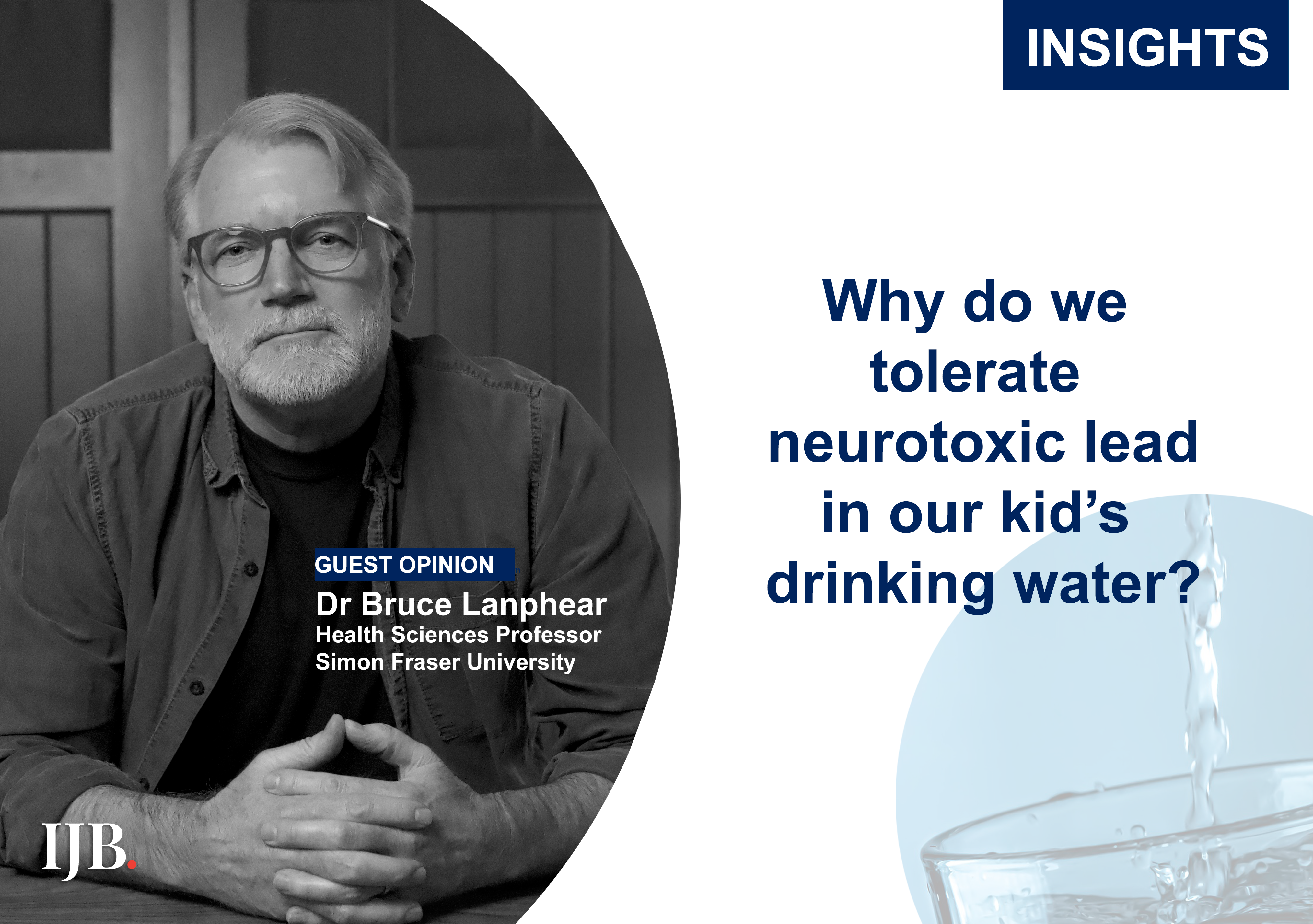
An expert in lead poisoning prevention asks why government officials continue to allow drinking water to be poisoned by lead.

Dr. Bruce Lanphear is a Health Sciences professor at Simon Fraser University. Bruce led influential studies used by federal agencies around the world to set standards for harmful levels of lead in air, paint, water, and house dust. His research convinced public health agencies that no safe level of lead could be identified.
When my wife, Nancy, was pregnant with our second child, she did everything by the book. Nancy was a pediatrician at the university hospital in Rochester, New York. She knew the basics: eat well, rest, drink plenty of water. She made a point of getting her eight cups a day, often from the hallway drinking fountain near her office.
Then, at 14 weeks gestation, she had a miscarriage.
A year later, we found out that the water fountains she had been using tested positive for astronomically high levels of lead—between 700 and 1,500 parts per billion (ppb). That’s up to 300 times higher than Health Canada’s current guideline of 5 ppb.
“The toxicity of lead has been extensively documented in humans.”
Health Canada
It wasn’t a new problem — the hospital had known about the contamination for a decade. Someone had even taped cardboard over the fountains with a warning. But over time, the cardboard came off, people forgot, and the fountains went back into use. No one told hospital staff. No one told Nancy.
She kept drinking from them, assuming the water—in a hospital of all places—was safe.
Lead in drinking water is an old problem, but it keeps showing up in new places—schools, daycares, hospitals, public buildings. We’ve known for over a century that lead is a poison, especially harmful to children and developing fetuses.
And yet, here we are, finding unacceptable levels of lead across Ontario’s public schools.
Historian Werner Troesken found that cities with lead service lines in early 20th-century Massachusetts had infant mortality rates 25 to 50 per cent higher, with even steeper increases in areas where acidic water corroded new lead pipes. Even back then, the connection between lead and harm was clear. But lead was cheap, malleable, and easy to work with. The lead industry pushed it hard. Cities bought it. Pipes were installed, and generations were quietly exposed.
These aren’t theoretical risks—they’re measurable, documented effects found in dozens of studies, including one funded by Health Canada. We now know that even very low levels of lead—far below what many governments still consider “actionable”—are linked to serious health problems.
“Lead in bone is released into blood during pregnancy and becomes a source of exposure to the developing fetus.”
World Health Organization
Lead exposure hits developing brains hardest. In a Canadian study, our team found that small increases in blood lead levels in pregnant women were a risk factor for premature birth, and lower IQ in their children.
A small drop in IQ might not seem dramatic in an individual case, but at a population level, it has real consequences. It shifts the curve. It increases the number of kids who struggle in school and decreases the number who thrive.
The effects of drinking water from lead pipes aren’t evenly distributed.
Those living in older, poorly maintained housing are more likely to be exposed to low-level lead, which is linked to hypertension, kidney disease, heart disease, and pregnancy loss in adults. Toxic lead drives up health care costs, decreases productivity, and worsens human suffering.
“Lead Exposure was attributed to more than 5.5 million deaths globally in 2019, primarily due to cardiovascular effects.”
Bjorn Larsen, Lancet Planetary Health, 2023
So why aren’t we holding building owners and public institutions accountable?
Part of the answer lies in outdated policy. Many health authorities still use an antiquated blood threshold – 100 ppb – to trigger concern. But research has shown harm at much lower values.
Acknowledging the risks of lead poisoning doesn’t mean routinely screening children during a well-child visit. It means removing the source. The solution isn’t more blood tests, it’s less lead. But when lead is found in blood samples, attention must turn to identifying and eliminating the sources.
But the inconvenient reality is that no amount of lead is safe.
The harmful impacts on health from lead exposure are entirely preventable.”
World Health Organization
We don’t need more research to know what to do. We need leaders to act with urgency. Remove lead-containing pipes and water fountains from schools, hospitals, and public buildings. Replace lead service lines. Update guidelines to reflect current science. And stop pretending that flushing lead pipes will solve the problem. It won’t.
Harvard researcher Ronnie Levin conducted a 2023 analysis demonstrating that the benefits of replacing lead service lines significantly outweigh the costs, with a benefit-to-cost ratio of 35:1. These actions could potentially prevent $9 billion in annual health care costs and save an additional $2 billion in infrastructure spending.
The takeaway is clear: removing lead isn’t just good policy—it’s a high-return investment.
It’s time to stop debating what level of lead is “acceptable” and start asking why any lead is acceptable at all.
Check the lead levels at your local school or daycare using the IJB Lead Tracker database.
Read the Investigation
One hundred times the federal government’s safety guideline.
That’s how much lead was found in the tap water at Fisher Park Public School in Ottawa last school year.
Seven other water tests taken at the school in the 2023-24 school year also exceeded the federal government’s lead safety guideline of 5 parts per billion (ppb). The highest reading found at Fisher Park was 567 ppb — among the worst in the province last year.
- INSIGHTS: Why aren’t withdrawn MAiD requests tracked in federal data? - 18 July 2025
- INSIGHTS: Is poor planning the real problem in hospitals? - 11 July 2025
- INSIGHTS: Hospital complaints come with a silver lining - 20 June 2025
